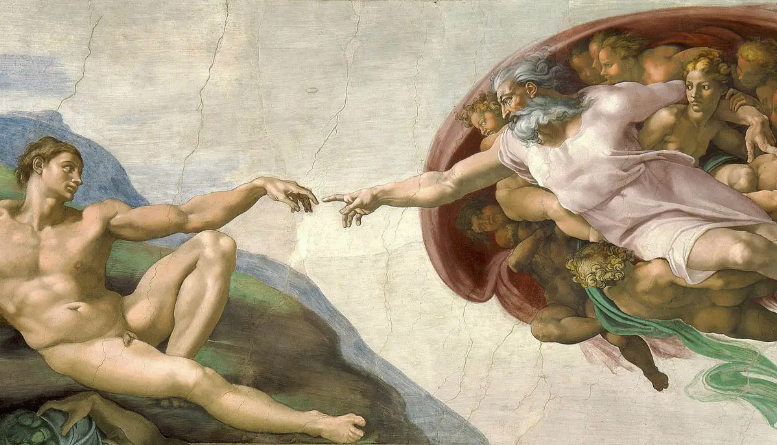“When fate lay dormant, life was ours,
We were friends of that time, while Azrael was a stranger”
Yusun Emre
We continue to tell the adventure of the “Ayrık1“. As we have stated in previous articles, by Ayrık, we mean both the one who is separated from the “unity” and the one who is thus subjected to stage separation, in other words, the fallen one who is on the separated stage. Our basis for the conceptual organization in this regard is the Anatolian Turkish conception of nazariyat and the author of this conception is Prof. Dr. Yalçın Koç. However, the views we present here have been shaped by us to the extent of our own understanding. Therefore, any errors or omissions are our own.
In the previous article, we discussed the courtship phase. Let us continue here.
The courtship phase of the Ayrık is shaped by many different conditions. The most important reason for this wide variety of circumstances is the development of its language and the change in its social life and its gradual transition into a cultural entity.
We will briefly touch on the linguistic aspect. Language in a broad sense has an erotic basis, and the “consciousness” and “mind” that are shaped accordingly have a high sexual charge. For example, “mind (mens)” is a place of touch, in this sense. So we don’t mean by this to have sexuality mentally; what we mean is more fundamentally about the nature of the mind. This is also a matter of language. The Ayrık, as the falling Ayrık, is simultaneously under the record of both its language in the broad sense, its consciousness, its mind, and its evolution on the basis of the Ayrık outer stage in terms of stage disjunction, and the evolution of its pragmatic “(Ayrık) inner” mind, consciousness and language on the basis of its inner stage, and the similar evolution and pragmatic writing, i.e. culture, of the communities in which it participates. This is why we walk with the idea of evolution and culture in mind.
But be warned; the source of language, consciousness and mind is not evolutionary biology. In other words, we cannot unpack language, consciousness, mind, or the “forces” at their source by centering on current evolutionary ideas. On the contrary, we open the existing ideas of evolution with the theory about language, consciousness, mind and forces. Moreover, we cannot even fully unpack a biological object, neither on the basis of evolutionary biology, nor on the basis of biology in general. The essence of biological beings and of biology is therefore not biological. We will touch briefly on these important points.
The endeavor to describe biological beings in a biologically based nature and to make people believe this is the endeavor of the pseudo-scientists of the Greek-Latin-Church realm. Their “subjects” in our country keep themselves and those in the middle busy by repeating this pastime here and there. Unfortunately, these subjects lack the consciousness to ask “fundamental” questions about biological beings to the pseudo-scientists of the Greek-Latin-Church realm in which they believe, and thus open up the issues from a broad and fundamental framework. This ignorance is “combined” with the ignorance of the theologians and their subjects who try to describe biological beings on a pseudo-religious basis, creating a false opposition and thus false causes and false fights. In the end, everyone returns to perpetuating “disunity” by sidling (essentially “fleeing” to their established posits) towards the arguments they find stronger, without any “demonstration” or “complete grounding”. However, such actions are incompatible with our identity, which has been forged with the love of truth, and with our scholarly tradition, which has been built by the sweat of our brow. Another reason for this sad picture in our country, in this respect, is that we have broken away from our original identity. This reason is more important and more decisive than being deceived by the Greek-Latin-Church realm. Because if one denies and deceives oneself first, one is open to others denying and deceiving them. In this respect, detachment from our original identity is self-denial and self-deception. Because our original identity is loaded with truths that cannot be “achieved” through mental reasoning, intellectual research and belief, litigation, fighting, prevailing and the like. Let us return to the subject.
To rephrase, the fact that the Ayrık is subject to evolution in terms of its body specific to the external scene does not mean that the human being is subject to evolution in its entirety and essentially. However, the Ayrık, as a fallen being, is also under the record of the formation of its body on its external stage; therefore, the evolutionary consequences must be taken into account in many respects. Let us continue by recalling these distinctions and contexts from the previous article.
The split (fallen) human body has evolved to be more receptive to “touch”. It is noteworthy in this respect that it is less hairy, almost hairless. However, there are also hairy parts of the split human. In particular, the body of the male Ayrık human is more hairy and some organs in particular are densely hairy. In this respect, hairiness cannot be adequately explained by sexuality alone. For example, the beard on men’s faces is pragmatically loaded with sexual signs, but also with signs of threat and demonstration. We can also recognize this by the fact that his voice is thicker, his limbs are larger and harder, and his muscular strength is higher. These are not things that can be adequately explained on the grounds of resisting harsh natural conditions alone. The lack of these signs of strength in the female human parts compared to the male must also be explained on a pragmatic basis.
Let us elaborate a little more in terms of feathers.
A beard connotes a man. If we say that it is because a man has a beard, that is why it is like this, we would be saying the right thing, but we would be saying it incompletely. The question is, what is the reason why beards as hair fall from women but not from men, or why they grow thicker? In answer to this, we can accept that it is again related to sexuality, but also on the basis of threat and vanity. In order to win over the opposite sex sex sexually, a man flaunts his large organs, loud voice and beard to rival men and appears aggressive. However, the same things are not necessary for the female. Among primates, the sexual life of females is not like that of males; it is more based on reproduction; this should not be forgotten. The female that behaves like the male primates is the split-human female; perhaps this is why we see that later on the split-human female will participate in competition based on “sexual touching” like males, despite her physical structure.
Males seem to have been shaped as stronger, bigger and tougher in terms of arm strength, both to intimidate their rivals and to withstand harsh environmental conditions in a broader sense, and we can consider the beards on this basis.
This is not the case with females. The female is more naked than the male. Nudity is both being more open to touch and inviting to be touched. In other words, the female is “more open to touch” and “inviting”. In general, animals need to be open to touch for reproduction. It is therefore natural for the female to be open to touch. Therefore, the areas that are open to touch are more related to reproduction; in the Ayrık human, it is also the “pleasure of touch” and the “rush of touch”. The female’s greater openness to being touched, in terms of reproduction, is shaped in such a way that she is more inviting to those who will touch her. And those who will touch are the males. So the issue of “contact” at this stage has made the male more of a toucher and the female more of a touched. She wants to be touched, he wants to be touched; this is what we mean. Conversely, she hides from being touched and he avoids being touched. These aspects can also shift in different ways. This is because the Ayrık, in general, suffers from “touch sickness”.
A female who wants to be touched has to invite it. The places to be touched are mostly places related to sexuality and reproduction. These places are shaped as inviting according to the pragmatic writing of the species. In other words, the place to be touched is shaped in such a way as to invite an invitation to this place. However, this condition, i.e. invitingness, also requires that this place be avoided in some way in cases other than touching. Places to be touched in non-inviting situations are therefore somehow hidden or protected. Females, in this respect, have been more skilled at both inviting and hiding. The invitation site is the most sensitive touch site in particular; for the same reason, it is also the place to hide. In Ayrık human females, this is the so-called vagina.
The simultaneous validity of invitation and concealment seems to be clearly represented in the state of the vagina before and after stimulation. The vagina has the appearance of a slit. Inside this slit, there is a hole that allows entry. By being a slit, the slit gives the impression that there is an entrance. However, the hole is not immediately clearly identifiable. The vaginal lips, which give the appearance of a slit, cover the hole. This covering can also be considered as a concealment of the hole. During stimulation, the labia fill with blood, both the inner and outer labia swell, redden and open. Thus, the hole appears, and there is even watering of the inner part close to the outside, which facilitates lubrication, as if to facilitate entry, and muscle contractions and relaxations become more frequent in the same place.
The difference between the vagina before and after is like a picture of concealment and invitation. However, since even an unstimulated vagina, in pragmatic writing, can be seen as a form of invitation, with the impression of a slit and a receptacle, the female has to hide her vaginal lips as well as her orifice. This concealment also occurs in such a way that both invitation and concealment occur at the same time.
Desmond Morris’ assumptions are noteworthy here.
According to him, the Ayrık human female was capable of both showing and hiding her genitals behind her back before she stood up (it should be recalled here that primates perform sexual intercourse by riding from behind). However, after standing up, the genitalia turned into an uninvited hiding, i.e. disappearing. It is significant in this respect that after standing up, many things reappear “as if redrawn” on the human face, that is, on the front. One of these is, of course, sexual pragmatics. According to these assumptions, compared to other primates, the fact that the human female has large breasts, flared lips on her face, and even earlobes of unknown function is a result of this sexual invitation.
The outward-facing lips resemble the vaginal area. Even, for example, the lips on the face become red and swollen during sexual stimulation. For example, the split-human can give many sexual messages with the lips on the face without showing the genitals; the split-human female is especially capable of this. The presence of these signs is due both to the shape of the lips during sexual stimulation and the touching activities performed with them (kissing, sucking), and to the structure of the lips that resembles a vagina. The first is a matter of “sign and connotation”, which can only be explained in terms that go beyond anatomy and zoology. The second is bodily-evolutionary imitation. That is, the face imitating the genitalia. According to these assumptions, other primates and even other animal species that need to show their genitalia have the data for this mimicry. This assumption, that there is bodily-evolutionary mimicry, is a remarkable assumption that extends to much wider contexts. We will not go into these far-reaching “assumptions” for now.
But let us give a hint. In general, the mouth has emerged as a place of sound and letter production and shaping in the formation of language. The structure of the human mouth and lips provides important advantages in the diversity of sounds and letters. A closed mouth evokes tranquility. Opening the mouth is a sign that something is coming. In other words, the mouth is, metaphorically speaking, fertile; and then it is the contactor. In mythological terms, the mouth is also similar to Khaos. It is also possible to make inferences from similar principles for the ear and the eye. All of these are receptive. In terms of language formation, the mouth can also function as a male limb. That is, in terms of what is produced, for example, speech. In this respect, the mouth, together with the word, is like the male-female: the sound comes out of it as if it were born, and after a certain point it is “extended”.
The female’s body shape; moulting, breast size and structure (not only in terms of breastfeeding, but more related to sexuality; if it were based on breastfeeding, it would have a bottle-like structure like in other primates, whereas the breasts of the split-human female are rounder and fuller, almost inviting to touch. So they can’t breastfeed comfortably like other primates. In other words, it is more difficult to breastfeed a child with these breasts), in places like the nose, they seem to be shaped in a way that invites sexual touching. The presence of breasts in the man of the split-human that are almost nothing like those of the woman, or other similarities that are sometimes seen, are related to the species-specific embryonic stage. This is common in the mammalian species. However, as pointed out above, the mammary structure of the Ayrık human female is based on lactation, combined with sexual touching and invitation.
Apart from invitational sexual evolution, sexual pragmatics itself is of course decisive in this regard. That is to say, the sexual pragmatics of the Ayrık human species determines its sexual evolution, its sexual culture and its culture in a broad sense. Let us remind again that the Ayrık human species is the species with the most intense sexual pragmatics among primates. The sexual pragmatics of the dissociated human being has to be considered together with the record of the dissociated internal scene and the pre-dissociation. The most important concept in this regard is “touching”. In this sense, the concept of touching has a meaning that goes far beyond sensual touching. Morris is not aware of how far the concept of “touching” in this sense “extends”.
We have said that the Ayrık human female is built more on the basis of being touched, and therefore shows characteristics of both invitation and hiding and concealing. However, we have also said that the male is more on the touching side. There are signs on the male body in this sense. The most obvious part that shows this is the so-called penis. Let us remind you that the largest and longest penis among the primates is the penis of the separate human male.
Being primarily a tactile being, the male is more capable of courtship, hunting and possession.
The phases in which the split-human moved towards “connection” with both the opposite sex and with his fellow primates more than other primates seem to have played a role in shaping the classification of “touch” and the predominating and atrophying aspects. “Cooperation” creates aspects of development and atrophy specific to the distribution of work. For example, the fact that hunting is mostly carried out by men has brought men to the forefront in the act of “reaching out” and “extending” to “seize”. For example, a weapon is a reaching and extending. Its essence is that “force” in a broad sense is “determined by limiting and shaping”. In other words, the Ayrık-human man “limits”, “shapes” and “determines” the “force” in the broad sense in his hand, and thus “extends” it in his own environment, in his own particular way, for example, to touch something else.
There are many things that a man extends in this way. For example, sometimes he draws a picture, sometimes he sings a song, sometimes he writes a book, sometimes he preaches, sometimes he proves a theorem, sometimes he posts or tweets on social media (in public). So he uses these things as reaching out and extending, for example, his penis. If anyone is interested in what he is extending, he gets pleasure from it; it’s like being hugged.
But of course we are not saying that the essence and every example of this is sexual reaching. But, however, as we get to know the individual and witness more and more examples of what he does in the world we live in, we can almost no longer assume any other motive in these matters. So non-sexual motives remain the exception. Let us move on.
It is also important to limit force for defense. But sexual reproduction, for example, is also a defense, in order to resist degradation, i.e. species extinction, for example. Defense must be considered in conjunction with the concept of “danger”. Danger means “that which is destructive”. Therefore, defense takes shape in the event of something being destroyed. What is to be defended determines the virtue or vileness of the defense. That is, not every defense is a virtue; similarly, not every danger is a vice. For example, the destruction of the non-self-existent Ayrık, that is, the “Ayrık scene,” on the basis of, for example, “a scene,” is a relative evil for the Ayrık, because the Ayrık, like all beings, is a being that wants to continue to exist; but in fact, its destruction on the basis of a scene is good for it in the sense that the Ayrık becomes a more essential being. On the contrary, the Ayrık’s defense of disunity against it, and its “reaching out and prolonging” for it, is essentially not a virtue for the Ayrık. For example, the Ayrık-thinkers of the Greco-Latin-Church realm find the coming of the Hatem in the Ancient Adam to bring them to one and the same essence dangerous, and so they “prolong” it through ideation, questioning, searching, forms of being. Like this one.
The issue of “limitation of force” must be addressed in terms of the concepts of arms and defense in their respective contexts. It should be dealt with on the basis of the broad concepts of “constitution, construction, establishment and construction”. We do not go into further details.
In the evolutionary stages, the development of men who engaged in hunting on the basis of “extension” through weaponry seems to have significantly influenced the writing of men through hunting on the basis of the human mind (mens). Both in men’s bodies and in their “internal pragmatics”, this period later manifested the “hunter-male-mind” in the cultures of “teaching, politics and economy”. Our taking of the teacher as a man in the previous posts should be understood in this light (but this is only for the mental, pragmatic and evolutionary context. There are other meanings to this work. For example, teaching cannot be seen as a concept only on the record of these points).
Similarly, in terms of their dominance in terms of sexual touch, men have sought and developed ways of touching, and have competed with rival “tall” men. At this point, the male has become competent in sexual competition. In this sense, the direction of competition develops from attacking what is to be seized, to defending what is seized from another attack. In other words, a man is competent both in attack and defense. For example, he is competent in attack through ambush, and he is competent in defense through precaution.
For example, some teachers, intellectually speaking, set traps and take over the student and indeed the world at large. The same is true of the politician.
The emergence of priests as teachers must be unpacked from this point of view. Priests, in this sense, are male hunters; in many cultures kings, and in the present day economic rulers too. In this sense, “capitalism” is a “structure” to be understood in terms of hunters-male-priests-kings. But this cannot be limited to the example of “capitalism”. That is to say, one must always look at the issue from a very broad perspective and pay attention to the contexts of virtue and vice.
Touch is not exclusive to men; it is a need of the Ayrık in general. However, in an inverted form, the desire to “merge” through touching is seen in a different dominant figure.
In other words, what we are trying to say here is that in terms of the classification and dominant figures in terms of touching, the follow-up points of the origin and walking principles of gradualization and determination should be carefully opened.
In terms of hunger, turning towards an object is also a need to touch, and it takes shape in the conditions necessary for each Ayrık hunger. However, it is important to open up touch on the basis of sexuality in terms of sexual identities and their mental determination in order to put many problems related to sexuality directly in front of us. The Ayrık human touches in a sexual sense both for reproduction and for touching, that is, for pleasure; and in this, the male is the prominent figure in terms of the act of “touching”, and the female as the touched and the inviter. In this respect, the Ayrık human-female has also come to resemble the male among primates. That is to say, the fact that almost all of the things identified above for the male are also increasingly evident in the split-female means that the split-human female has in many ways become a false male. At this point, the issue becomes less about male and female and more about “being human”. This is precisely what the “stage” is all about, which is that human beings, both male and female, from an evolutionary point of view, should have been based on one and the same “virtue” in very recent history. This phase also corresponds to the “revelation-based celestial religious phase” as it is known. In these respects, this phase is “invisible” and “incomprehensible” through dialectical idealism, dialectical materialism, psychoanalytic readings of history and, more broadly, through intellectuality (logia).
For example, we would say that the male is feminine in one aspect and the female is masculine in another aspect; but more fundamentally, it must be made clear that the distinction between male and female is based on a transcendent unity on another initial basis, but that it is the separate pragmatic software that takes these aspects out of consideration. It is in this software that the conflicts and cultural crises that have emerged over time in the relative male-female customs are caused by the failure to clearly articulate their specific bases and transition points. However, attempting to change the ground of a distinct entity’s own phase by violating it without opening its ground on the basis of some transcendental unity also creates a different kind of crisis. The hunter-philosophers make many efforts to create precisely these conditions of crisis, as pointed out above.
Therefore, it is not possible to get a comprehensive picture of these issues unless the principles of the emergence of the philosopher as well as the principles of the emergence of the priest are unified.
We will continue where we left off.
1-The author uses the word “Ayrık” in the same sense as the term “Sapiens”.





